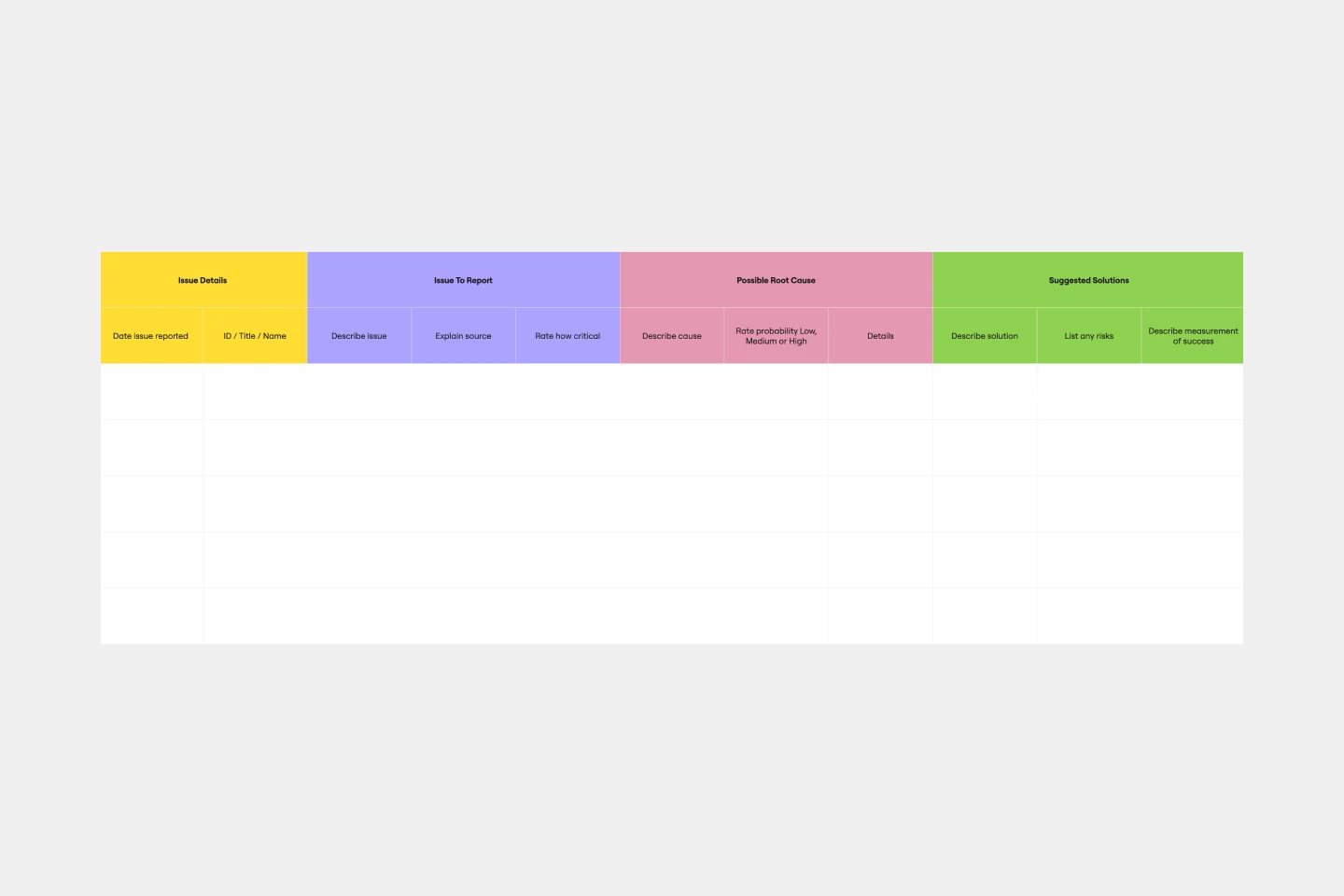5 Whys Templates
Miro's 5 Whys templates help you identify root causes and solve problems effortlessly. Whether you're troubleshooting or improving processes, these templates provide a clear structure to dig deeper, uncover insights, and drive effective solutions.
Root Cause Analysis (RCA) Template
Works best for:
Strategy, Planning
The Root Cause Analysis (RCA) Template is a structured tool that helps teams uncover the underlying reasons behind specific problems or events. By pinpointing and addressing these root causes, rather than just treating the symptoms, organizations can foster long-term solutions and prevent recurring challenges, leading to more efficient and sustainable operations.
5 Whys Template
Works best for:
Design Thinking, Operations, Mapping
Ready to get to the root of the problem? There’s no simpler way to do it than the 5 Whys technique. You’ll start with a simple question: Why did the problem happen? Then you’ll keep asking, up to four more times, until the answer becomes clear and you can work toward a solution. And Miro’s features enhance the approach: You can ask team members questions in chat or @mention them in comments, and use color-coded sticky notes to call out issues that are central to the problem at hand.
Fishbone Diagram Template
Works best for:
Operations, Diagrams, Workflows
What is the best way to solve any problem your team faces? Go straight to the root. That means identifying the root causes of the problem, and fishbone diagrams are designed to help you do it best. Also known as the Ishikawa Diagram (named after Japanese quality control expert Kaoru Ishikawa), fishbone diagrams allow teams to visualize all possible causes of a problem, to explore and understand how they fit together holistically. Teams can also use fishbone diagrams as a starting point for thinking about what the root cause of a future problem might be.
Root Cause Evaluation Template
When you first encounter a complex situation, it's not common to immediately delve into its underlying causes and effects. Often, we grasp the overall picture but fail to separate the problem from its surrounding circumstances. Root Cause Evaluation provides a method to better understand the interconnected factors that have contributed to the current situation.
Join thousands of teams collaborating and doing their best work on Miro.
Sign up freeAbout the 5 Whys Templates Collection
The 5 Whys is a powerful problem-solving tool used to identify the root cause of an issue by asking "why" five times. This technique is essential in business for uncovering the underlying causes of problems, enabling teams to implement effective solutions and prevent recurrence. Miro's 5 Whys templates collection offers a structured approach to this method, making it accessible and easy to use for professionals at any level.
Why you'll love the 5 whys templates
Using Miro's 5 Whys templates provides several benefits:
Structured problem-solving: The templates guide you through each step of the 5 Whys process, ensuring a thorough analysis.
Collaboration: Miro's collaborative platform allows team members to contribute in real time, fostering a collective approach to problem-solving.
Visualization: The templates help visualize the problem and its root causes, making it easier to understand and communicate findings.
Efficiency: By providing a ready-made framework, the templates save time and ensure consistency in the problem-solving process.
Flexibility: The templates can be customized to fit the specific needs of your team or project.
Sticky notes: Use sticky notes for quick brainstorming and organizing information visually.
Miro AI for Insights: Leverage Miro AI to gain deeper insights and streamline the analysis process.
How to use the 5 whys templates in Miro
Access the template: Start by choosing one of the 5 Whys template on Miro's template library.
Define the problem: Clearly state the problem you are trying to solve at the top of the template.
Ask the first why: Write down the first "why" question related to the problem and answer it.
Repeat the process: Continue asking "why" for each subsequent answer until you have asked five times. Each answer should lead you closer to the root cause.
Analyze the root cause: Once you have identified the root cause, discuss potential solutions with your team.
Implement solutions: Develop an action plan to address the root cause and prevent the problem from recurring.
Miro's 5 Whys templates are a valuable tool for any team looking to improve their problem-solving capabilities. By providing a structured, collaborative, and visual approach, these templates help teams identify root causes and implement effective solutions, ultimately driving better business outcomes.
